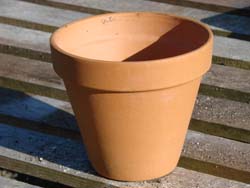One-Pot Herb Garden Brings Sage and Summer Memories Indoors

Growing herbs indoors during Winter provides a welcome, fragrant reminder of Summer in the chilly heart of Winter. A one-pot garden is a good solution if you miss your outdoor kitchen garden but don’t have much room in front of your sunniest window.
While some herbs need plenty of water, others -- such as many types of Culinary Sage -- need little. Aside from controlling soil moisture, keys to success when planting a one-pot garden containing sages include:
• Selecting the right companion plants
• Choosing a pot that drains well and isn’t too large
• Using a potting mix that is good for herbs
• Providing sufficient warmth and sunlight, and
• Giving the residents of your one-pot garden regular haircuts to keep growth under control.
Companions for Culinary Sage
A good rule of thumb when combining sages with other plants in a container is to place it with other herbs of Mediterranean origin that are accustomed to drier, leaner soils. Good companions include Sweet Marjoram (Origanum majorana), Oregano (Origanum vulgare), Rosemary (Rosmarinus officinalis) and Thyme (Thymus vulgaris).
Slower growing dwarf species may help keep growth under control within limited space. However, at Flowers by the Sea, we have never found a dwarf Culinary Sage that performs to our expectations. Instead, for a one-pot garden, we suggest some of our favorite shorter cultivars, such as Greek Sage (S. fruticosa) and Honey Melon Pineapple Sage (S. elegans ‘Honey Melon’) all of which reach a height of about 24 inches if not regularly trimmed.
By sharing what you snip with family and friends, any abundance will become a pleasure instead of a problem.
Container Size
Sometimes decorative pots don’t have sufficient drainage. However, if you plant your herb garden in a smaller, simpler container with multiple drainage holes, you can tuck it inside a pretty pot. A planting pot with a diameter and height of 12 inches is a good minimal size to accommodate about three to four 3.5-inch starter pots of herbs and requires about 3.5 gallons of potting mix.
Beware of over-potting when selecting your container size. If it is too big and your plants are surrounded by lots of potting mix, their roots may rot from overexposure to moisture.
Potting Mix
Not only does garden soil need to be sterilized in your oven if you plan to incorporate it into your potting mix – which creates a potentially unpleasant smell lasting for several days – but also its fine particles may retain moisture longer than is good for plants requiring drier, well-drained soil.
Commercial potting mixes for herbs should primarily contain composted bark, sand, a limited amount of nitrogen and volcanic rock such as perlite, pumice or lava rock. If you can’t find a bagged mix meeting these requirements, it’s easy to customize your own basic mix by combining 1 part standard potting mix (the bark, sand and fertilizer) to 1 part volcanic rock.
Place about 3 inches of the mix at the bottom of the pot and water it. Gently slide your plants out of their starter pots and distribute them evenly in the 8-inch container. Then fill around them with potting mix and water until moist, but not soggy.
Warm, Sunny Window
Herbs need a warm, sunny, indoor location such as a south-facing window where they can obtain six hours or more of sunlight daily. If sunlight is in short supply, a plant stand equipped with grow lights – such as 40-watt fluorescent fixtures – can be used to supplement available sun.
Although many herbs tolerate low overnight temperatures outdoors, the plants in your one-pot garden likely will thrive at temperatures between 60 and 75 degrees F.
Water Needs
Herbs need more watering when planted in containers than in the ground where their roots are free to spread far, go deep and seek moisture. So you should never let the soil of a potted plant become dusty dry.
To determine dryness, touch the top of the potting mix to feel for coolness, then gently stick a finger into the mix to draw out some soil and rub it between your fingers to feel for moisture. Another good idea is to note how heavy the pot feels after a watering. Lift the pot again the next day or so to determine how heavy it feels compared to right after watering. When the pot begins feeling light, it’s time to water again.
Indoor Pruning
Herbs are pretty to look at, but they get leggy without pruning. You can pinch them back with your fingernails or use sharp shears for trimming. This also maintains order in the pot by not allowing any one plant to dominate the shared territory.
Shared Experiences
If you are an indoor herb gardener and have some thoughts and/or photos to share, please contact us at FBTS. We would love to hear what has and hasn’t worked for you. Meanwhile, we wish you happy planting adventures both indoors and outside.

 Salvia elegans 'Honey Melon'
Salvia elegans 'Honey Melon'
Comments
There are no comments yet.